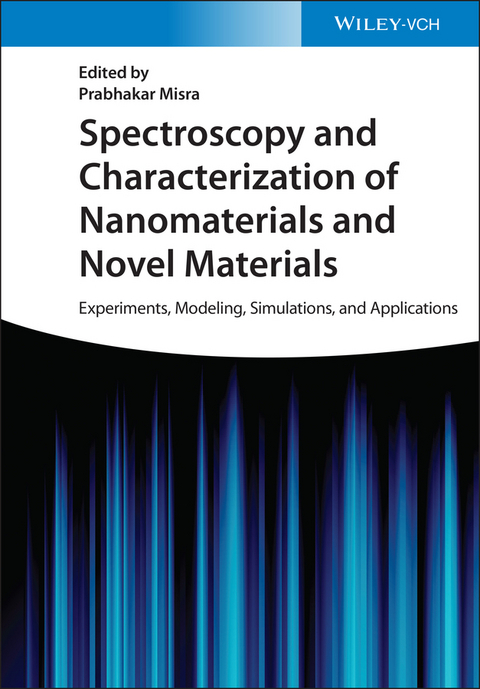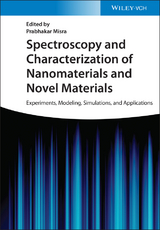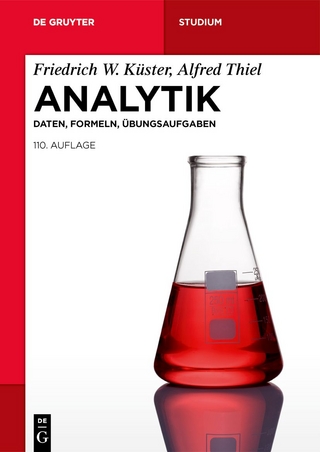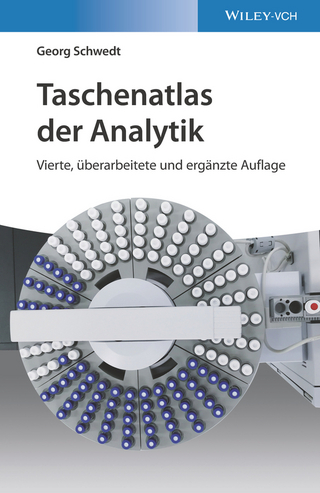Spectroscopy and Characterization of Nanomaterials and Novel Materials
Wiley-VCH (Verlag)
978-3-527-34937-1 (ISBN)
Prabhakar Misra is Professor in the Department of Physics and Astronomy at Howard University, Washington DC, USA. He has more than 25 years work experience in (i) Raman spectroscopy of nanomaterials, (ii) detection and spectroscopic characterization of free radicals, stable molecules, molecular ions and ionic clusters, (iii) high resolution molecular spectroscopy in the infrared employing, and (iv) absorption of short-pulsed laser radiation.
Preface xix
About the Editor xxvii
Part I Spectroscopy and Characterization 1
1 Spectroscopic Characterization of Graphitic Nanomaterials and Metal Oxides for Gas Sensing 3
Olasunbo Farinre, Hawazin Alghamdi, and Prabhakar Misra
1.1 Introduction and Overview 3
1.1.1 Graphitic Nanomaterials 3
1.1.1.1 Synthesis of Graphitic Nanomaterials 5
1.1.2 Metal Oxides 8
1.2 Spectroscopic Characterization of Graphitic Nanomaterials and Metal Oxides 9
1.2.1 Graphitic Nanomaterials 9
1.2.1.1 Characterization of Carbon Nanotubes (CNTs) 10
1.2.1.2 Characterization of Graphene and Graphene Nanoplatelets (GnPs) 11
1.2.2 Characterization of Tin Dioxide (SnO2) 12
1.3 Graphitic Nanomaterials and Metal Oxide-Based Gas Sensors 19
1.3.1 Fabrication of Graphitic Nanomaterials-Based Gas Sensors 19
1.3.1.1 Carbon Nanotube (CNT)-Based Gas Sensors 19
1.3.1.2 Graphene and Graphene Nanoplatelet (GnP)-Based Gas Sensors 20
1.3.2 Fabrication of Metal Oxide-Based Gas Sensors 21
1.3.2.1 Tin Dioxide (SnO2)-Based Gas Sensors 23
1.4 Conclusions and Future Work 24 Acknowledgments 26 References 26
2 Low-dimensional Carbon Nanomaterials: Synthesis, Properties, and Applications Related to Heat Transfer, Energy Harvesting, and Energy Storage 33
Mahesh Vaka, Tejaswini Rama Bangalore Ramakrishna, Khalid Mohammad, and Rashmi Walvekar
2.1 Introduction 33
2.2 Synthesis and Properties of Low-dimensional Carbon Nanomaterials 35
2.2.1 Zero-dimensional Carbon Nanomaterials (0-DCNs) 35
2.2.1.1 Fullerene 35
2.2.1.2 Carbon-encapsulated Metal Nanoparticles 35
2.2.1.3 Nanodiamond 37
2.2.2 Onion-like Carbons 38
2.2.3 One-dimensional Carbon Nanomaterials 39
2.2.3.1 Carbon Nanotube 39
2.2.3.2 Carbon Fibers 39
2.2.4 Two-dimensional Carbon Nanomaterials 40
2.3 Applications 42
2.3.1 Hydrogen Storage 42
2.3.2 Solar Cells 43
2.3.3 Thermal Energy Storage 44
2.3.4 Energy Conversion 45
2.4 Conclusions 46
References 46
3 Mesoscale Spin Glass Dynamics 55
Samaresh Guchhait
3.1 Introduction 55
3.2 What Is a Spin Glass? 56
3.2.1 Spin Glass and Its Correlation Length 57
3.2.2 Mesoscale Spin Glass Dynamics 60
3.3 Summary 64 Acknowledgments 64 References 64
4 Raman Spectroscopy Characterization of Mechanical and Structural Properties of Epitaxial Graphene 67
Amira Ben Gouider Trabelsi, Feodor V. Kusmartsev, Anna Kusmartseva, and Fatemah Homoud Alkallas
4.1 Introduction 67
4.2 Epitaxial Graphene Mechanical Properties Investigation 68
4.2.1 Optical Location of Epitaxial Graphene Layers 68
4.2.2 Raman Location of Mechanical Properties Changes 71
4.2.2.1 Graphene 2D Mode 71
4.2.2.2 G Mode Investigation 74
4.2.2.3 Strain Percentage 76
4.3 Raman Polarization Study 77
4.3.1 Size Domain of Graphene Layer 77
4.3.2 Polarization Study 78
4.4 Conclusions 80 Acknowledgments 80 References 80
5 Raman Spectroscopy Studies of III?V Type II Superlattices 83
Henan Liu and Yong Zhang
5.1 Introduction 83
5.2 Raman Study on InAs/GaSb SL 84
5.2.1 Analysis on (001) Scattering Geometry 85
5.2.2 Analysis on (110) Scattering Geometry 86
5.3 Raman Study on InAs/InAs1-xSbx SL 90
5.3.1 Raman Results for the Constituent Bulks and InAs1-xSbx Alloys 90
5.3.2 Analysis on (001) Scattering Geometry for the SLs 93
5.3.3 Analysis on (110) Scattering for the SLs 95
5.4 A Comparison Among the InAs/InAs1-xSbx, InAs/GaSb, and GaAs/AlAs SLs 97
5.5 Conclusion 98
References 98
6 Dissecting the Molecular Properties of Nanoscale Materials Using Nuclear Magnetic Resonance Spectroscopy 101
Nipanshu Agarwal and Krishna Mohan Poluri
6.1 Introduction to Nanomaterials 101
6.2 Techniques Used for Characterization of Nanomaterials 104
6.3 Nuclear Magnetic Resonance (NMR) Spectroscopy 105
6.3.1 Principle of NMR Spectroscopy 106
6.3.2 Various NMR Techniques Used in Nanomaterial Characterization 106
6.3.2.1 One-dimensional NMR Spectroscopy 108
6.3.2.2 Relaxometry (T1 and T2) 108
6.3.2.3 Two-dimensional NMR Spectroscopy 110
6.3.3 Advantages and Disadvantages of Using NMR Spectroscopy 114
6.4 Applications of NMR in Nanotechnology 115
6.4.1 NMR for Characterization of Nanomaterials 115
6.4.1.1 Characterization of Gold Nanomaterials by NMR 115
6.4.1.2 Characterization of Organic Nanomaterials by NMR 119
6.4.1.3 Characterization of Quantum Dots and Nanodiamonds by NMR 120
6.4.2 Elucidating the Molecular Characteristics/Interactions of Nanomaterials Using NMR 120
6.4.2.1 Characterizing Nanodisks Using Paramagnetic NMR 120
6.4.2.2 Characterizing Nanomaterials Using Low Field NMR (LF-NMR) 123
6.4.2.3 Analyzing Nanomaterial Interactions Using 2D NMR Techniques 123
6.4.3 Characterization of Magnetic Contrast Agents (MR-CAs) 128
6.5 Conclusions 132 Acknowledgments 132 References 132
7 Charge Dynamical Properties of Photoresponsive and Novel Semiconductors Using Time-Resolved Millimeter-Wave Apparatus 149
Biswadev Roy, Branislav Vlahovic, M.H. Wu, and C.R. Jones
7.1 Introduction 149
7.1.1 Why Charge Dynamics for Novel Materials in the Millimeter-Wave Regime? 150
7.1.2 Underlying Theory of Operation and Time-Resolved Data: Treatment of Internal Fields in Samples 154
7.1.3 Apparatus Design and Instrumentation 156
7.1.4 Sensitivity Analysis and Dynamic Range 158
7.1.5 Calibration Factor 159
7.2 Studies on RF Responses of Materials 162
7.2.1 Transmission and Reflection Response for GaAs 162
7.2.2 Silicon Response by Resistivity 162
7.2.2.1 Charge Carrier Concentration 165
7.2.2.2 Millimeter-Wave Probe and Laser Data 166
7.2.2.3 TR-mmWC Charge Dynamical Parameter Correlation Table and Sample-Resistivity 168
7.2.2.4 Photoconductance (¿G) Using Calculated Sensitivity 171
7.3 CdSxSe1-x Nanowires 174
7.3.1 Transmission and Reflection Response Spectra for CdX Nanowire 174
7.3.2 Millimeter-Wave Signal Coherence and Decay Response of CdSxSe1-x Nanowire 176
7.4 Conclusions 182
7.5 Data: CdSxSe1-x TR-mmWC Responses for Various Pump Fluences 182
Acknowledgments 183
References 183
8 Metal Nanoclusters 187
Sayani Mukherjee and Sukhendu Mandal
8.1 Introduction 187
8.2 Gold Nanoclusters 189
8.2.1 Phosphine-protected Au-NCs 190
8.2.2 Thiol-protected Nanoclusters 193
8.2.2.1 Brust?Schiffrin Synthesis 193
8.2.2.2 Modified Brust?Schiffrin Synthesis 194
8.2.2.3 Size-focusing Method 197
8.2.2.4 Ligand Exchange-induced Structural Transformation 200
8.2.3 Other Ligands as Protecting Agents 202
8.3 Mixed Metals Alloy Nanoclusters 202
8.4 Conclusion 203
8.5 Future Direction 203 Acknowledgment 204 References 204
Part II Modeling and Simulation 211
9 Simulations of Gas Separation by Adsorption 213
Hawazin Alghamdi, Hind Aljaddani, Sidi Maiga, and Silvina Gatica
9.1 Introduction 213
9.2 Simulation Methods 216
9.2.1 Molecular Dynamics Simulations 216
9.2.2 Monte Carlo Simulations 217
9.2.3 Ideal Adsorbed Solution Theory (IAST) 218
9.3 Models 220
9.3.1 Molecular Models 220
9.3.2 Substrate Models 221
9.3.3 Validation of the Methods and Force Fields 222
9.4 Examples 223
9.4.1 GCMC Simulation of CO2/CH4 Binary Mixtures on Nanoporous Carbons 223
9.4.2 MD Simulations of CO2/CH4 Binary Mixtures on Graphene Nanoribbons/Graphite 224
9.4.3 MD Simulations of H2O/N2 Binary Mixtures on Graphene 228
9.4.4 Calculation of the Selectivity of CO2 and CH4 on Graphene Using the IAST 231
9.5 Conclusion 236
References 236
10 Recent Advances in Weyl Semimetal (MnBi2Se4) and Axion Insulator (MnBi2Te4) 239
Sugata Chowdhury, Kevin F. Garrity, and Francesca Tavazza
10.1 Introduction 239
10.2 Discussion 241
10.2.1 MBS 242
10.2.2 MBT 243
10.3 Outlook 252
References 253
Part III Applications 261
11 Chemical Functionalization of Carbon Nanotubes and Applications to Sensors 263
Khurshed Ahmad Shah and Muhammad Shunaid Parvaiz
11.1 Introduction 263
11.2 Properties of Carbon Nanotubes 267
11.2.1 Electrical Properties 267
11.2.2 Mechanical Properties 269
11.2.3 Optical Properties 269
11.2.4 Physical Properties 271
11.3 Properties of Functionalized Carbon Nanotubes 272
11.3.1 Mechanical Properties 272
11.3.2 Electrical Properties 272
11.4 Types of Chemical Functionalization 273
11.4.1 Thermally Activated Chemical Functionalization 273
11.4.2 Electrochemical Functionalization 273
11.4.3 Photochemical Functionalization 274
11.5 Chemical Functionalization Techniques 274
11.5.1 Chemical Techniques 274
11.5.2 Electrons/Ions Irradiation Techniques 275
11.5.3 Specialized Techniques 275
11.6 Sensing Applications of Carbon Nanotubes 276
11.6.1 Gas Sensors 276
11.6.2 Biosensors 277
11.6.3 Chemical Sensors 277
11.6.4 Electrochemical Sensors 278
11.6.5 Temperature Sensors 278
11.6.6 Pressure Sensors 278
11.7 Advantages and Disadvantages of Carbon Nanotube Sensors 278
11.8 Summary 279
References 280
12 Graphene for Breakthroughs in Designing Next-Generation Energy Storage Systems 287
Abhilash Ayyapan Nair, Manoj Muraleedharan Pillai, and Sankaran Jayalekshmi
12.1 Introduction 287
12.2 Li?Ion Cells 289
12.2.1 Basic Working Mechanism 289
12.2.2 Role of Graphene: Graphene Foam-Based Electrodes for Li?Ion Cells 291
12.3 Li?S Cells 294
12.3.1 Advantages of Li?S Cells 295
12.3.2 Working of Li?S Cells 295
12.3.3 Challenges of Li?S Cells 296
12.3.4 Graphene-Based Sulfur Cathodes for Li?S Cells 297
12.3.5 Graphene Oxide-Based Sulfur Cathodes for Li?S Cells 298
12.4 Supercapacitors 299
12.4.1 Basic Working Principle 299
12.4.2 Graphene-Based Supercapacitor Electrodes 300
12.4.3 Graphene/Polymer Composites as Electrodes 303
12.4.4 Graphene/Metal Oxide Composite Electrodes 305
12.5 Li?Ion Capacitors 306
12.5.1 Working Principle 306
12.5.2 Graphene/Graphene Composites as Cathode Materials 307
12.5.3 Graphene/Graphene Composites as Anode Materials 309
12.6 Looking Forward 310
References 311
13 Progress in Nanostructured Perovskite Photovoltaics 317
Sreekanth Jayachandra Varma and Ramakrishnan Jayakrishnan
13.1 Introduction 317
13.2 Nanostructured Perovskites as Efficient Photovoltaic Materials 318
13.3 Perovskite Quantum Dots 321
13.4 Perovskite Nanowires and Nanopillars 324
13.4.1 2D Perovskite Nanostructures 326
13.4.2 2D/3D Perovskite Heterostructures 330
13.5 Summary 336
References 336
14 Applications of Nanomaterials in Nanomedicine 345
Ayanna N. Woodberry and Francis E. Mensah
14.1 Introduction 345
14.2 Nanomaterials, Definition, and Historical Perspectives 345
14.2.1 What Are Nanomaterials? 345
14.2.2 Origin and Historical Perspectives 346
14.2.3 Synthesis of Nanomaterials 349
14.2.3.1 Inorganic Nanoparticles 349
14.3 Nanomaterials and Their Use in Nanomedicine 351
14.3.1 What Is Nanomedicine? 351
14.3.2 The Myth of Small Molecules 351
14.3.3 Nanomedicine Drug Delivery Has Implications that Go Beyond Medicine 351
14.3.4 Improvement in Function 351
14.3.5 Nanomaterials Use in Nanomedicine for Therapy 351
14.3.5.1 Progress in Polymer Therapeutics as Nanomedicine 351
14.3.5.2 Recent Progress in Polymer: Therapeutics as Nanomedicines 352
14.3.5.3 Use of Linkers 354
14.3.5.4 Targeting Moiety 354
14.3.6 Polymeric Drugs 355
14.3.7 Polymeric-Drug Conjugates 355
14.3.8 Polymer?Protein Conjugates 356
14.4 The Use of Nanomaterials in Global Health for the Treatment of Viral Infections Such As the DNA and the RNA Viruses, Retroviruses, Ebola, and COVID-19 356
14.4.1 Nanomaterials in Radiation Therapy 358
14.5 Conclusion 359
References 359
15 Application of Carbon Nanomaterials on the Performance of Li-Ion Batteries 361
Quinton L. Williams, Adewale A. Adepoju, Sharah Zaab, Mohamed Doumbia, Yahya Alqahtani, and Victoria Adebayo
15.1 Introduction 361
15.2 Battery Background 362
15.2.1 Genesis of the Rechargeable Battery 362
15.2.2 Battery Cell Classifications 363
15.2.2.1 Primary Batteries ? Non-rechargeable Batteries 363
15.2.2.2 Secondary Batteries ? Rechargeable Batteries 363
15.2.3 Comparison of Rechargeable Batteries 363
15.2.4 Internal Battery Cell Components 364
15.2.4.1 Cathode 365
15.2.4.2 Anode 366
15.2.4.3 Electrolyte 366
15.2.5 Crystal Structure of Active Materials 366
15.2.5.1 Layered LiCoO2 367
15.2.5.2 Spinel LiM2O4 367
15.2.5.3 Olivine LiFePO4 368
15.2.5.4 NCM 369
15.2.6 Principle of Operation of Li-Ion Batteries 370
15.2.7 Battery Terminology 371
15.2.7.1 Battery Safety 373
15.2.8 A Glimpse into the Future of Battery Technology 374
15.3 High C-Rate Performance of LiFePO4/Carbon Nanofibers Composite Cathode for Li-Ion Batteries 375
15.3.1 Introduction 375
15.3.2 Experimental 375
15.3.2.1 Preparation of Composite Cathode 375
15.3.2.2 Characterization 376
15.3.3 Results and Discussion 376
15.3.4 Summary 379
15.4 Graphene Nanoplatelet Additives for High C-Rate LiFePO4 Battery Cathodes 380
15.4.1 Introduction 380
15.4.2 Experimental 381
15.4.2.1 Composite Cathode Preparation and Battery Assembly 381
15.4.2.2 Characterizations and Electrochemical Measurements 382
15.4.3 Results and Discussion 382
15.4.4 Summary 386
15.5 LiFePO4 Battery Cathodes with PANI/CNF Additive 386
15.5.1 Introduction 386
15.5.2 Experimental 386
15.5.2.1 Preparation of the PANI/CNF Conducting Agent and Coin Cell 387
15.5.3 Results and Discussion 387
15.5.4 Conclusion 392
15.6 Reduced Graphene Oxide ? LiFePO4 Composite Cathode for Li-Ion Batteries 393
15.6.1 Introduction 393
15.6.2 Experimental 394
15.6.3 Results and Discussion 394
15.6.4 Summary 398
15.7 Rate Performance of Carbon Nanofiber Anode for Lithium-Ion Batteries 398
15.7.1 Introduction 398
15.7.2 Experimental 398
15.7.3 Results and Discussion 399
15.7.4 Summary 401
15.8 NCM Batteries with the Addition of Carbon Nanofibers in the Cathode 402
15.8.1 Introduction 402
15.8.2 Experimental 403
15.8.3 Results and Discussion 403
15.8.4 Summary 405
15.9 Conclusion 407 Acknowledgments 407 References 408
Part IV Space Science 415
16 Micro-Raman Imaging of Planetary Analogs: Nanoscale Characterization of Past and Current Processes 417
Dina M. Bower, Ryan Jabukek, Marc D. Fries, and Andrew Steele
16.1 Introduction 417
16.2 Relationships Between Minerals 421
16.2.1 Minerals in the Solar System 421
16.2.2 Minerals as Indicators of Life and Habitability 425
16.3 Planetary Analogs 427
16.3.1 Modern Terrestrial Analogs 427
16.3.2 Ancient Terrestrial Analogs 429
16.4 Meteorites and Lunar Rocks 431
16.5 Carbon 434
16.5.1 Definition and Description of Macromolecular Carbon 434
16.5.2 Macromolecular Carbon on the Earth and in Astromaterials 435
16.5.3 Macromolecular Carbon in Petrographic Context 437
16.6 Conclusion 439
References 439
17 Machine Learning and Nanomaterials for Space Applications 453
Eric Lyness, Victoria Da Poian, and James Mackinnon
17.1 Introduction to Artificial Intelligence and Machine Learning 453
17.1.1 What Do We Mean by Artificial Intelligence and Machine Learning? 454
17.1.2 The Field of Data Analysis and Data Science 455
17.1.2.1 Data Analysis 455
17.1.2.2 Data Science 455
17.1.3 Applications in Nanoscience 456
17.2 Machine Learning Methods and Tools 457
17.2.1 Types of ML 457
17.2.1.1 Supervised 457
17.2.1.2 Unsupervised 459
17.2.1.3 Semi-supervised 460
17.2.1.4 Reinforcement Learning 460
17.2.2 The Basic Techniques and the Underlying Algorithms 460
17.2.2.1 Regression (Linear, Logistic) 460
17.2.2.2 Decision Tree 461
17.2.2.3 Neural Networks 461
17.2.2.4 Expert Systems 463
17.2.2.5 Dimensionality Reduction 463
17.2.3 Available Tools: Discussion of the Software Available, Both Free and Commercial, and How They Can Be Used by Nonexperts 464
17.3 Limitations of AI 464
17.3.1 Data Availability 464
17.3.1.1 Splitting Your Dataset 464
17.3.2 Warnings in Implementation (Overfitting, Cross-validation) 465
17.3.3 Computational Power 465
17.4 Case Study: Autonomous Machine Learning Applied to Space Applications 466
17.4.1 Few Existing AI Applications for Planetary Missions 466
17.4.2 MOMA Use-Case Project (Leaning Toward Science Autonomy) 467
17.5 Challenges and Approaches to Miniaturized Autonomy 468
17.5.1 Computing Requirements of AI/Machine Learning 468
17.5.2 Why Is Space Hard? 469
17.5.3 Software Approaches for Embedded Hardware 471
17.6 Summary: How to Approach AI 473
References 474
Index 477
| Erscheinungsdatum | 27.04.2022 |
|---|---|
| Verlagsort | Weinheim |
| Sprache | englisch |
| Maße | 170 x 244 mm |
| Gewicht | 1132 g |
| Themenwelt | Naturwissenschaften ► Chemie ► Analytische Chemie |
| Technik ► Elektrotechnik / Energietechnik | |
| Technik ► Maschinenbau | |
| Schlagworte | Chemie • Chemistry • Components & Devices • Electrical & Electronics Engineering • Elektrotechnik u. Elektronik • Komponenten u. Bauelemente • materials characterization • Materials Science • Materialwissenschaften • Nanomaterial • spectroscopy • Spektroskopie • Werkstoffprüfung |
| ISBN-10 | 3-527-34937-5 / 3527349375 |
| ISBN-13 | 978-3-527-34937-1 / 9783527349371 |
| Zustand | Neuware |
| Informationen gemäß Produktsicherheitsverordnung (GPSR) | |
| Haben Sie eine Frage zum Produkt? |
aus dem Bereich




